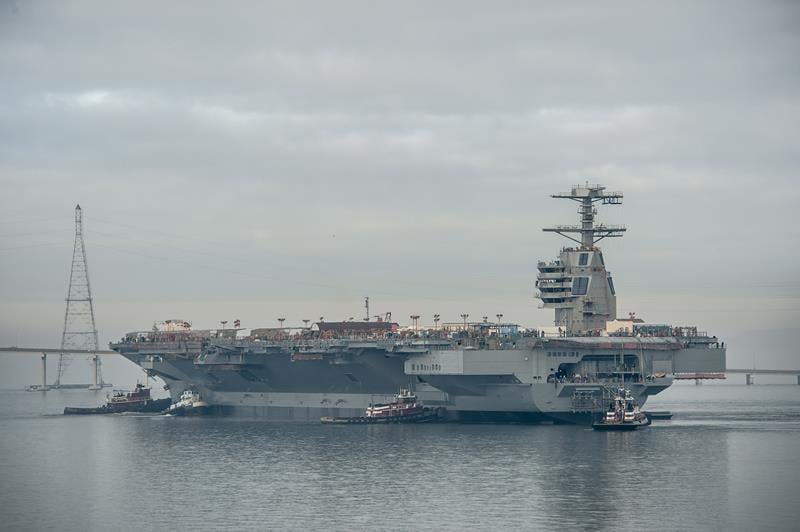
The new carrier USS Ford is afloat but still unfinished.
THE WHITE HOUSE SITUATION ROOM, CA. 2025: “Where are the carriers?”
“In the scrapyard, Mr. President. How about some submarines?”
That’s a parody, not a projection. But this hypothetical future isn’t that far off from what experts from four top thinktanks — AEI, CNAS, CSBA, and CSIS — presented this morning as the “least unacceptable” option to deal with the deep budget cuts known as sequestration.
To be clear, none of the four teams in a recent “budget wargame” simulating the next 10 years chose to scrap all the flattops or even most of them. None of them even stopped building the new Ford-class carriers. Instead they opted to keep the industrial base alive with new production while retiring two, three, or even four of the existing carriers, which would avoid expensive mid-life overhauls like the one the USS George Washington is due to start this year.
The thinktankers suggested sharp cuts to the carrier fleet — and to the kind of short-ranged fighter aircraft it currently carries — in order to protect what they considered higher-priority programs in space, cyberspace and under the sea (both manned attack submarines and future unmanned mini-subs). What’s more, although each team’s carrier cuts were part of a much larger package of budgetary nips and tucks to deal with sequestration, in an alternative scenario where defense spending would be cut by only half the amount of the full sequester, all four teams still chose to cut carriers — and to cut the exact same number as they had in their worst-case scenarios.
In other words, cutting the Navy’s iconic flagships wasn’t something recommended as a last resort: It was one of the first expedients the thinktankers resorted to in order to save money. That consensus suggests that support for aircraft carriers is surprisingly soft at the core of what we might call the defense-intellectual complex. That softness, in turn, seems to stem from an agreement that the Pacific in general and China in particular should be our top priority — as enshrined in the Obama administration’s 2012 “Defense Strategic Guidance” — and, in turn, that China’s ever-increasing arsenal of hackers, submarines, and long-range missiles requires us to invest in cyberwarfare, underwater, and long-range strike systems of our own
The consensus for carrier cuts was what struck me most about the briefing by experts from the Center for Strategic and Budgetary Assessments, which designed the budget-cut simulator, and the conservative American Enterprise Institute, the pro-Obama Center for a New American Security, and the relentlessly centrist Center for Strategic and International Studies. (All the participants emphasized they were speaking for themselves, not for their institutions). But there was a lot else going on.
Unsurprisingly, when they went looking for savings through a CSBA-designed database of some 800 different spending options, all four teams hammered the Army. In the worst-case, full-sequester scenario, CNAS cut the Army budget by more than 10 percent, CSBA by 13 percent, AEI by 14 percent, and CSIS by a whopping 16 percent. But that’s not news to anyone immersed in defense debates, especially not to anyone in the Army, where they’ve gotten used to real-world budgetary beatings, never mind hypothetical ones.
Likewise it’s unsurprising that all four teams delayed the Army’s new Ground Combat Vehicle (that’s already happening) and scrapped all or most of the Air Force’s A-10 Warthog ground-attack aircraft, the Army’s favorite Air Force plane. They also slashed short-ranged non-stealthy fighters in general in favor of some mix of drones, missiles, and a new long-range stealth bomber. All but AEI cut the stealthy F-35 Joint Strike Fighter as well. Other usual suspects included base closures and cutting the Defense Department civilian and contractor workforce. All these cuts, in turn, freed up funds for all four think tanks to increase spending on space and cyberspace programs even as total defense spending went down.
The four teams’ proposals were of course outlines, not full budget plans — but the Pentagon has resolutely failed to provide an official plan for how it would implement a full sequester. That’s irresponsible but understandable, said the head of the CSIS team, David Berteau.
“Look at it from DoD’s perspective,” said Berteau, a former Pentagon official himself with many budget-battle scars. “If you actually make those cuts, you’re going to make some really bad, unacceptable decisions.” (“Least unacceptable” was Berteau’s term for the teams’ proposals). And if DoD lays out an actual plan of cuts to meet full sequestration, he said, there’s a real risk that “the US Congress looks at it and says, ‘That ain’t so bad, why don’t we take that?'”
Berteau’s not alone in such skepticism of Congress: No less an icon of iconoclasm than Senator John McCain showed up to slam his colleagues. “Sequestration was an abrogation of our responsibility to make broad choices,” he fumed. “We are paying a very heavy price for it.”
McCain made sure to praise the thinktankers’ hard work — but he also made clear such inside-the-Beltway discussions are only just a start. If we really want to shape the debate, he said, he and his colleagues must “bring our discussion to our constituents around the country [to] make them understand we live in a world that still requires American leadership.”
Navy jet trainer fleet operations remain paused after engine mishap
One week after the incident, a Navy spokesperson says the service is continuing to assess the fleet’s ability to safely resume flight.


























